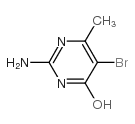Comparation interferon- inducing and antiviral properties of 2-amino-5-bromo-6-methyl-4-pyrimidinol (U-25,166), tilorone hydrochloride, and polyinosinic-polycytidylic acid.
D A Stringfellow
Index: Antimicrob. Agents Chemother. 11(6) , 984-92, (1977)
Full Text: HTML
Abstract
2-Amino-5-bromo-6-methyl-4-pyrimidinol (U-25,166), polyinosinic acid-polycytidylic acid [poly(I:C)], and tilorone HCl induced high levels of serum interferon in mice. Each consequently protected mice against infection with several viruses. After daily injection of inducer, mice developed a reduced interferon response (hyporeactivity) to each compound. However, hyporeactivity developed more slowly to U-25,166 and poly(I:C) than to tilorone HCl. After onset of hyporeactivity, 5 to 6 days without each inducer were required before normal serum interferon levels could be stimulated. Animals also developed a hyporeactive state as a consequence of Semliki Forest or encephalomyocarditis virus infections. By day 2 of either infection, mice had a suppressed interferon response to tilorone HCl, but remains responsive to poly(I:C) or U-25,166 until day 4. In vivo, poly(I:C) stimulated interferon production in a variety of cells and organs, whereas the tilorone HCl and U-25,166 responses involved a nonlymphoid component of the reticuloendothelial system. In vitro, poly(I:C) induced interferon in a variety of murine cells, U-25,166 was active in murine thymus and spleen organ cultures, and tilorone was inactive. These data indicate that U-25,166 is an interesting low-molecular-weight interferon inducer.
Related Compounds
| Structure | Name/CAS No. | Molecular Formula | Articles |
|---|---|---|---|
 |
4(3H)-Pyrimidinone,2-amino-5-bromo-6-methyl-
CAS:6307-35-3 |
C5H6BrN3O |
|
Enhancement of resistance to Listeria monocytogenes infectio...
1984-01-01 [Clin. Invest. Med. 7(4) , 343-8, (1984)] |
|
Antineoplastic properties of pyrimidinone interferon inducer...
1980-01-01 [Adv. Enzyme Regul. 19 , 335-48, (1980)] |
|
Interferon induction by 5-halo-6-phenyl pyrimidinones.
1980-01-01 [J. Interferon Res. 1(1) , 1-14, (1980)] |
|
Varying role of alpha/beta interferon in the antiviral effic...
1991-01-01 [Antiviral Res. 15(3) , 241-54, (1991)] |
|
Antiviral and interferon-inducing properties of interferon i...
1980-03-01 [Antimicrob. Agents Chemother. 17(3) , 455-60, (1980)] |